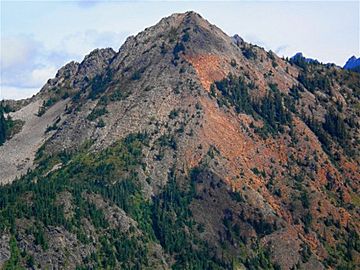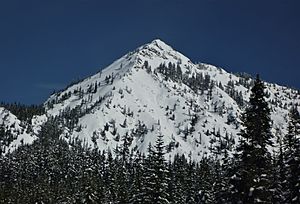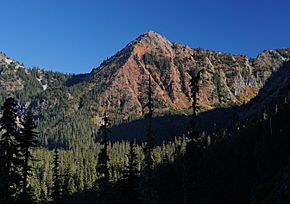Red Mountain (King County, Washington) facts for kids
Quick facts for kids Red Mountain |
|
|---|---|

Red Mountain seen from Guye Peak
|
|
| Highest point | |
| Elevation | 5,890 ft (1,800 m) |
| Prominence | 530 ft (160 m) |
| Isolation | 1.3 mi (2.1 km) |
| Parent peak | Snoqualmie Mountain (6,278 ft) |
| Geography | |
| Location | King County Washington state, U.S. |
| Parent range | Cascade Range |
| Topo map | USGS Snoqualmie Pass |
| Climbing | |
| First ascent | 1898 W.C. Mendenhall |
| Easiest route | Scrambling |
Red Mountain is a tall mountain in Washington state. It stands 5,890 feet (about 1,795 meters) high. You can find it in King County.
This mountain is part of the Alpine Lakes Wilderness. This wild area is inside the Cascade Range. Red Mountain is about three miles north of Snoqualmie Pass. It is on land managed by the Mount Baker-Snoqualmie National Forest.
The closest higher mountain is Lundin Peak, which is about 0.7 miles (1.1 km) to the northwest. Rain and melting snow from the mountain's north side flow into the Middle Fork of the Snoqualmie River. Water from the south side goes into the South Fork Snoqualmie River through Commonwealth Creek.
Mountain Weather
Red Mountain has a "marine west coast" climate. This means it gets a lot of moisture from the Pacific Ocean. Most weather systems come from the Pacific and move northeast.
When these weather systems hit the Cascade Range, they are forced to rise. As the air goes up, it cools and drops its moisture. This causes a lot of rain or snow to fall on the mountains. This process is called orographic lift.
Because of this, the western side of the Cascades gets a lot of precipitation. This is especially true in winter, when heavy snowfall is common. Winters are usually cloudy. However, in summer, high-pressure systems over the Pacific Ocean often bring clear skies.
The snow here tends to be wet and heavy. This can create a high risk of avalanches. The best time to visit or climb Red Mountain is usually from July to September. The weather is most favorable then.
How the Mountain Formed
The Alpine Lakes Wilderness has very rugged land. You can see jagged peaks, sharp ridges, and deep valleys carved by glaciers. There are also granite rock walls and over 700 mountain lakes.
Long ago, big geological events shaped the land. These events created the varied landscape and huge changes in elevation across the Cascade Range. This also led to different climate zones.
The Cascade Mountains started forming millions of years ago. This was during the late Eocene Epoch. At that time, the North American Plate was slowly moving over the Pacific Plate. This movement caused many volcanic eruptions.
Also, small pieces of the Earth's crust, called terranes, joined together. This helped create the North Cascades about 50 million years ago.
Over two million years ago, during the Pleistocene period, glaciers played a big role. Huge sheets of ice moved forward and backward many times. They scraped and shaped the land. The last glaciers in the Alpine Lakes area started melting about 14,000 years ago. They were gone from the Canada–US border by 10,000 years ago.
The "U"-shaped valleys you see were formed by these glaciers. The combination of land being pushed up (uplift) and cracks forming in the Earth (faulting), along with glaciation, created the tall peaks and deep valleys of the Alpine Lakes Wilderness.




